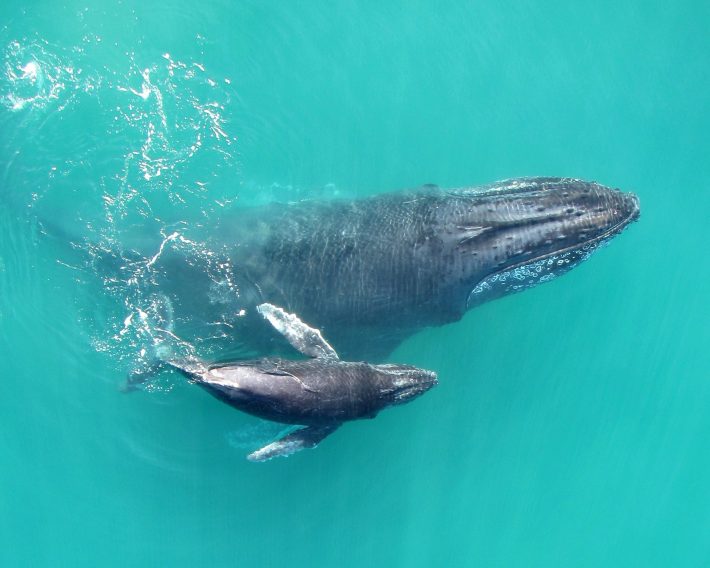Press Release: ‘Whispering’ keeps humpbacks safe from killer whales, study finds
Newborn humpback whales ‘whisper’ to their mothers to avoid being overheard by killer whales, researchers have discovered. The recordings – the first obtained from tags directly attached to the whales – are published today in Functional Ecology.

Ecologists from Denmark and Australia used temporary tags on humpback mothers and their calves in Exmouth Gulf off western Australia to learn more about the first months of a humpback’s life.
According to lead author Simone Videsen of the University of Aarhus:
“We know next to nothing about the early life stages of whales in the wild, but they are crucial for the calves’ survival during the long migration to their feeding grounds.”
“This migration is very demanding for young calves. They travel 5,000 miles across open water in rough seas and with strong winds. Knowing more about their suckling will help us understand what could disrupt this critical behaviour, so we can target conservation efforts more effectively.”
Humpbacks spend their summer in the food-rich waters of the Antarctic or Arctic, and in the winter migrate to the tropics to breed and mate. While in tropical waters such as Exmouth Gulf, calves must gain as much weight as possible to embark on their first, epic migration.
Together with colleagues from Murdoch University, Videsen tagged eight calves and two mothers. To capture the faint sounds of the calves, they used special tags developed by the University of St Andrews.
The tags attach to whales via suction cups and record sounds made and heard by whales, along with their movements, for up to 48 hours before detaching to float at the surface.
The study found that mothers and calves spend significant amounts of time nursing and resting. The recordings also revealed that newborn humpbacks communicate with their mothers using intimate grunts and squeaks – a far cry from the loud, haunting song of the male humpback whale.
The data tags showed that these quiet calls usually occurred while whales were swimming, suggesting they help mother and calf keep together in the murky waters of Exmouth Gulf. “We also heard a lot of rubbing sounds, like two balloons being rubbed together, which we think was the calf nudging its mother when it wants to nurse,” says Videsen.
Such quiet communication helps reduce the risk of being overheard by killer whales nearby, she believes: “Killer whales hunt young humpback calves outside Exmouth Gulf, so by calling softly to its mother the calf is less likely to be heard by killer whales, and avoid attracting male humpbacks who want to mate with the nursing females.”
The findings will help conserve this important humpback habitat and – crucially – ensure these nursery waters are kept as quiet as possible.
“From our research, we have learned that mother-calf pairs are likely to be sensitive to increases in ship noise. Because mother and calf communicate in whispers, shipping noise could easily mask these quiet calls.”
There are two major humpback whale populations, one in the northern hemisphere and the other in the south. Both breed in the tropics during the winter and then migrate to the Arctic or Antarctic during the summer to feed.
Humpback whales are slow to reproduce. Pregnancy lasts for around one year and calves – which are 5 metres at birth – stay with their mothers until they are one year old. During their first weeks of life, calves can grow by up to one metre per month.
Like what we stand for?
Support our mission and help develop the next generation of ecologists by donating to the British Ecological Society.